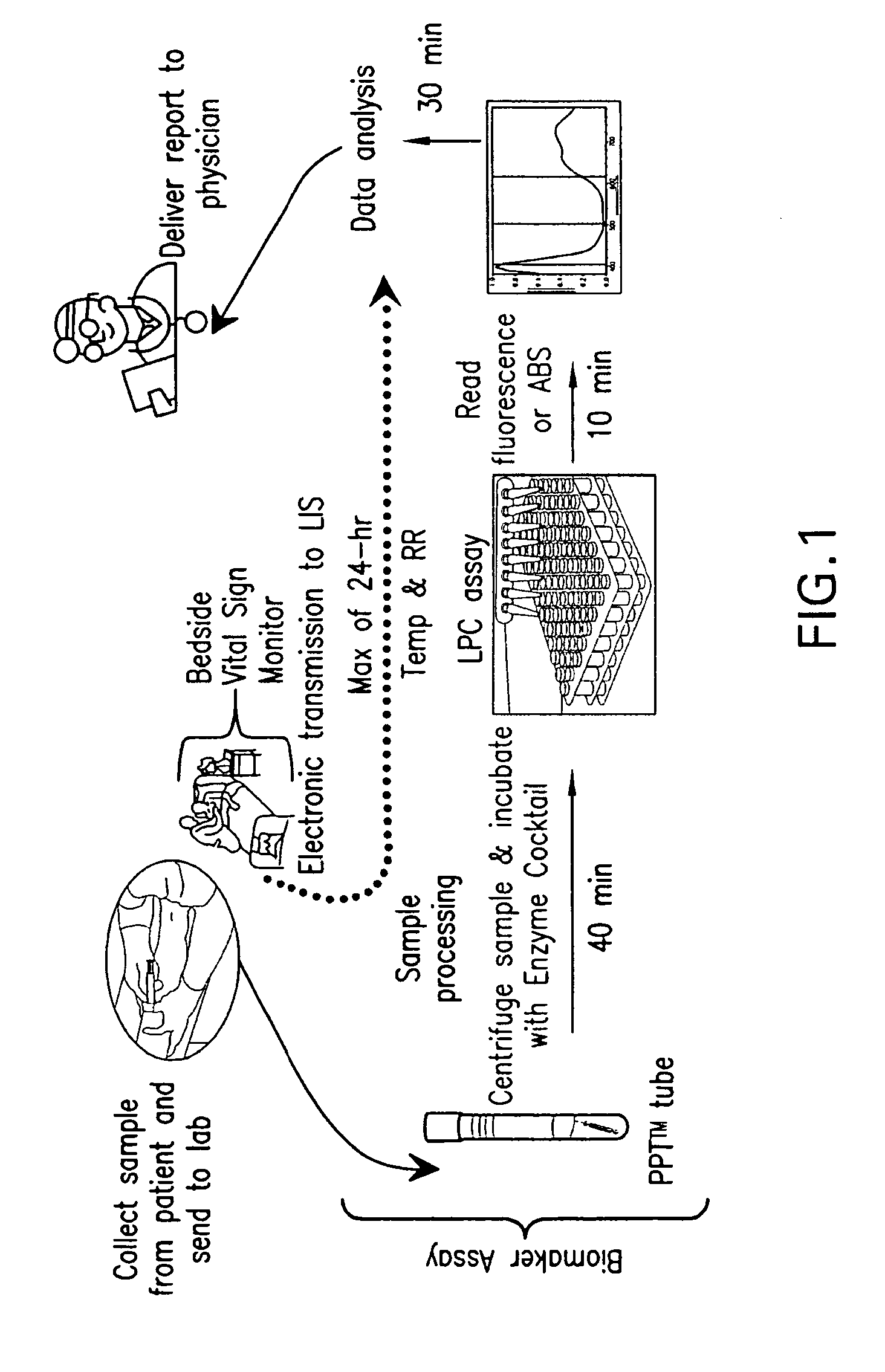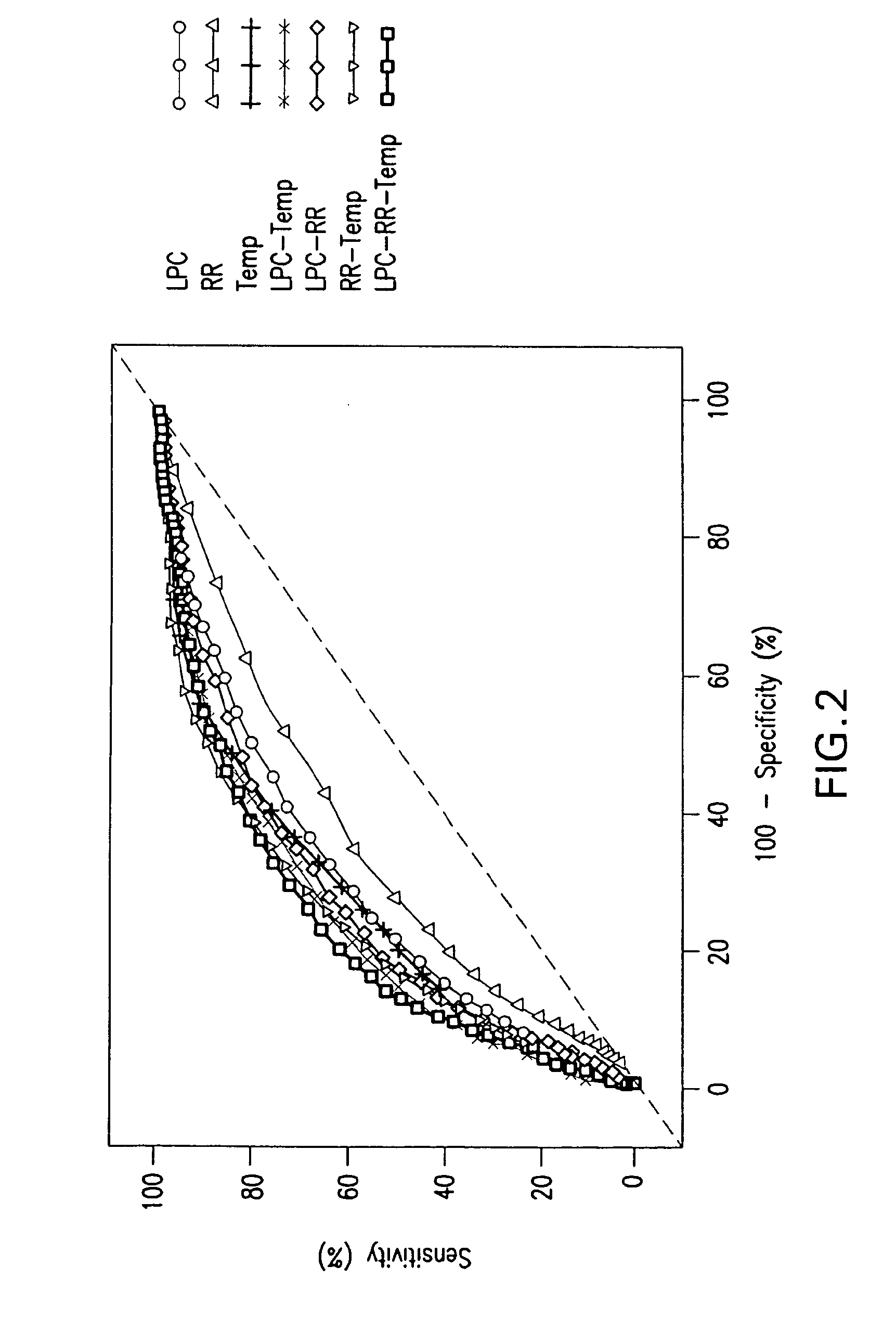Advanced Detection of Sepsis
a sepsis and advanced technology, applied in the field of advanced sepsis detection, can solve the problems of difficult understanding of the complex response of the host during the septic response, difficulty in early detection of disease symptoms, and difficulty in detecting early symptoms of disease, so as to increase the likelihood of sepsis ons
- Summary
- Abstract
- Description
- Claims
- Application Information
AI Technical Summary
Benefits of technology
Problems solved by technology
Method used
Image
Examples
example 1
6.1 Example 1
Performance as Measured by Out-of-Bag Cross-Validation for lysophosphatidylcholine, temperature, respiratory rate, and Other Biomarkers as Predictors of Sepsis Using Logistic Regression Algorithms
[0374]Examples 1 and 2 are provided that illustrate four data sets and two algorithmic approaches. The data sets document lysophosphatidylcholine performance as a stand alone marker and provide examples of selecting clinical markers or additional biomarkers that improve lysophosphatidylcholine performance as a predictor for sepsis.
[0375]Example 1 illustrates “out-of-bag” cross-validation of logistic regression results for lysophophatidylcholine, temperature, respiratory rate, and other biomarkers. In each example, 400 iterations of “out-of-bag” performance estimation were carried out. That is, for each of 400 iterations, 10% of the patients were randomly selected between the SIRS and sepsis training populations to be excluded from fitting, then predicted, forming the basis for ...
example 2
6.2 Example 2
Performance of Lysophosphatidylcholine, Temperature, and Respiratory Rate as Predictors of Sepsis Using Bayesian Longitudinal Algorithms
[0384]Example 2 illustrates Bayesian Longitudinal algorithm results for the lysophophatidylcholine, temperature and respiratory rate. SIRS and sepsis data were modeled in moving windows of up to 3 days, and assay results were modeled as a multivariate longitudinal model within the window, in which assay results were assumed to vary linearly at a plurality of time points. Predictions for new subjects were made according to their estimated probability of belonging to the sepsis population. This probability was calculated by comparing probability densities of the new data for the SIRS and sepsis populations and weighing prevalence, i.e., by Bayes' theorem. Moreover, the parameters of the SIRS and sepsis longitudinal models are themselves estimated using Bayesian statistics which yield a “posterior” probability distribution over the unknown...
example 3
6.3 Example 3
Predicted Performance of Lysophosphatidylcholine, Temperature, and Respiratory Rate Markers for the Advanced Detection of Sepsis
[0389]Example 3 illustrates that lysophosphatidylcholine, temperature and respiratory rate can be used for the advanced detection of sepsis in a subject. The example also illustrates that the inclusion of the temperature and respiratory rate markers significantly increases the accuracy of the lysophosphatidylcholine model for advanced detection.
[0390]In this example, historical models were applied to a test population of 257 subjects.
[0391]Historical Training and Model Building
[0392]Cross-validation performed on training data and each model (LPC, Temp, LPC and Temp, Temp and RR, and LPC, Temp and RR) used an out-of-bag, boot strapping sampling procedure iterated N times (N=400), where at each iteration logistic regression models were fit and predicted probabilities computed for samples held back from the model. Then a threshold was selected for...
PUM
| Property | Measurement | Unit |
|---|---|---|
| body temperature | aaaaa | aaaaa |
| body temperature | aaaaa | aaaaa |
| time | aaaaa | aaaaa |
Abstract
Description
Claims
Application Information
 Login to View More
Login to View More - R&D
- Intellectual Property
- Life Sciences
- Materials
- Tech Scout
- Unparalleled Data Quality
- Higher Quality Content
- 60% Fewer Hallucinations
Browse by: Latest US Patents, China's latest patents, Technical Efficacy Thesaurus, Application Domain, Technology Topic, Popular Technical Reports.
© 2025 PatSnap. All rights reserved.Legal|Privacy policy|Modern Slavery Act Transparency Statement|Sitemap|About US| Contact US: help@patsnap.com



